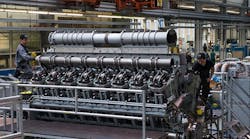The Federal Reserve reported Monday that U.S. industrial production unexpectedly dropped 0.2% in May, following a downwardly revised 0.5% drop in April. Economic forecasts had initially anticipated a 0.2% increase.
The drop was due in part to the continued decrease in mining output, which continued its downward trend with a 0.3% dip in May and a 1.3% dip in April. Petroleum and coal products (1.6%), food, beverage and tobacco products (0.9%), miscellaneous durable goods (0.7%), aerospace and miscellaneous transportation equipment (0.5%), chemicals (0.5%), electrical equipment and appliances (0.5%) and paper (0.5%) all also dropped.
“Manufacturing’s decline was widespread last month, with production down in 12 of the 20 major industries,” MAPI Foundation chief economist Daniel Meckstroth said. “There was strong growth in motor vehicles and parts but the gain was mostly offset by lost production in petroleum and coal products.
““The moribund activity in April and May is disconcerting, considering that last year production came roaring back in the spring and summer following a difficult winter. Sentiment indicators, including the purchasing managers index, imply moderate production growth but it is not yet reflected in the industrial production report.”
Meckstroth added that production in the motor vehicle industry is a “bright spot,” with increases of 1.7% in May, 2.0% in April and 4.0% in March. Primary metals (0.7%), computer and electronic products (0.4%), machinery (0.4%), apparel and leather products (0.3%) and wood products (0.2%) all also gained in May.
Despite these more recent drops, manufacturing production is still up 1.8% year over year, though its growth has slowed from a 4.5% pace as recently as November. Capacity utilization has declined five straight months, from 79.6% in December to 78.1% in May.
In addition, the most recent National Association of Manufacturers outlook index dropped to 51.7 earlier this month, down from 61.7 in December, “a significant decline in sentiment in such a short period of time,” NAM chief economist Chad Moutray said. “Estimates of growth for sales, capital spending and employment have also decelerated sharply, even as they continue to reflect modest growth moving forward.
“Exports are expected to grow more sluggishly, with a stronger U.S. dollar and slowing economies abroad dampening demand.”




